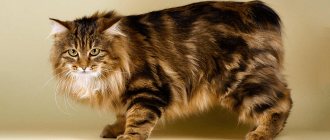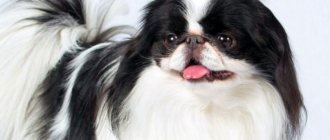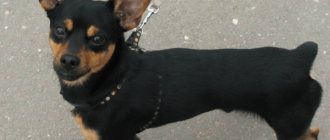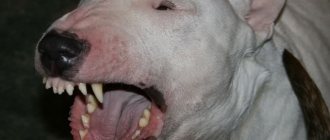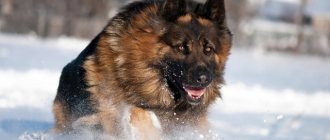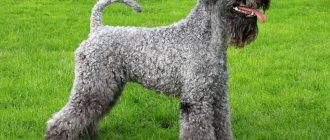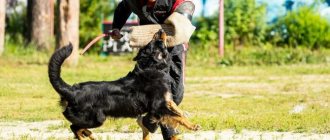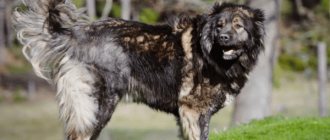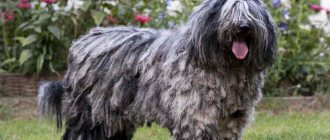One of the largest and oldest breeds in the world is the Irish Wolfhound. Its representatives serve in the Irish Guards, guarding Buckingham Palace and Her Majesty the Queen.
Wolfhound is a collective name for large breeds of dogs used to hunt wolves or to protect pastures from wolves. When choosing a pet among hunting breeds, decide on the desired characteristics.
If you need a watchdog, the Irish Wolfhound is definitely not suitable. The dog is often called a "gentle giant." Let us first consider these main representatives of the group. Why did the Queen of Great Britain love wolfhounds?
History of the origin of the breed
Since ancient times, Khotosho were widespread in Central Asia, Tibet, Buryatia and Mongolia. They were faithful companions of man in all spheres of his life: hunting, guarding home and livestock, as a huge nanny for the owner’s children.
It is interesting that many legends are associated with this breed, or rather its origin.
The most famous of them:
- The ancient ancestor of the breed, a female Buryat-Mongolian wolfhound named Sarama, served directly the god Indra. She was distinguished by a special black and tan color. But the main feature was the presence of red spots on the dog’s forehead, which were located surprisingly symmetrically above the eyes. This gave the impression that the dog had four eyes. The ancient Buryats believed that a dog brings happiness to the house in which it lives. This belief has survived to this day;
- Khotosho once saved people from starvation by persuading Buddha to save grain on ears of grain.
Currently, animals of this breed occupy a special place in Buddhism. They are revered as sacred.
The formation of the breed proceeded through natural selection. Almost no selection was carried out. Except for selecting the strongest puppies from the litter. By the end of the 20th century, the breed was in danger of extinction. No one was involved in breeding.
The revival of the breed is associated with the activities of two enthusiasts: Marika Teregulova and Nikolai Batov. They organized expeditions to remote areas of Buryatia, where representatives of the breed could still be found. Breeding nurseries were organized in which the first offspring were obtained.
They created the breed standard. True, so far it has not been possible to achieve official recognition, and the breed is still considered rare. But she is no longer in danger of disappearing.
In addition to the most famous and official name, you can hear such names as: Mongolian Shepherd, Caucasian, Hun dog, Tibetan dog or simply wolfhound.
Photo: topsimages.com
Story
Khotosho accompanies the owner on trips
More ancient than the Tibetan mastiffs, the Buryat Mongolian wolfhound appeared in the vastness of Buryatia and Mongolia many centuries ago. It is not known whether he came along with the Huns, or was a local aborigine, but in the excavations of the Hun settlement, archaeologists found the remains of dogs similar to Khotosho. These large dogs were residents of Buddhist monasteries and accompanied shamans in the Mongolian steppes, guarded livestock in Tuva and protected human habitation in the impenetrable Siberian taiga.
Such a large habitat of the wolfhound became the reason for some diversity in the population, due to which the breed was not recognized by cynological organizations for many years. The final breed standard was adopted only after 2000. Enthusiasts from Russia in the eighties assembled an expedition to Mongolia and Buryatia, looked for documents in monasteries and collected data on the basis of which a standard was drawn up. Today, the Buryat Mongolian Wolfhound is considered a revived breed, the ancestors of which were aboriginal dogs.
The secrets of one procedure: how to trim dogs' nails yourself
Dachshund: all about the most loyal dog
Description of the breed
The breed standard was established in 2006.
Breed requirements:
- Males always exceed females in size. Height at the withers: male - not less than 0.74 meters, female - not less than 0.66 meters. The dog is considered large and the weight of a male dog can reach up to 80 kilograms.
- The head is large, with well-defined cheekbones;
- The legs are very muscular, above average length;
- The dog's body is developed, with large muscles, barely noticeable under thick fur;
- The ears are triangular, medium in size, hanging;
- The eyes should be oval shaped. Color - from amber to dark brown. There are wolfhounds with blue eyes, which is considered a breed defect;
- Scissor bite. The dog's teeth should be very white, tightly adjacent to each other;
- The coat is quite hard combined with a dense soft undercoat;
- There are types: with long hair (hair length up to 30 cm), medium hair (up to 10 cm) and short hair (up to 5 cm). Despite the difference in coat length, all individuals shed equally heavily;
- The classic color is black and tan with a small white spot on the chest. It is preferred, but brown, brown, gray, black colors in various combinations are allowed;
- It is believed that Khotosho is a crossbreed of the Buryat-Mongolian wolfhound; less stringent requirements are imposed on them.
Difference between Khotosho and Bankhar
Often these two concepts merge and it is believed that these are two names for the same breed. This is wrong. Khotosho is a mixed breed, a yard dog. The word “hotosho” itself is translated from Buryat as “yard dog”, “yard guard”.
But the bankhar is a dog that carries all the characteristics of a pure breed. From the Mongolian language it is translated as “puffy”, “fluffy”, “filled with wool”.
They differ in appearance: the bankhar is larger than the bankhar, because the Mongols strictly observe the size of dogs; excess weight will interfere with the bankhar's movement.
Photo: bankhar.org
Standard
Khotosho at the exhibition
General appearance: self-confident, large (75 centimeters at the withers), strong, but not loosely built animal. Athletically built, harmonious and proportional, with an attentive gaze, not showing aggression or timidity. The movements are confident, sweeping, balanced. The aboriginal name “banhar”, which means fluffy or thick, best characterizes the appearance of the wolfhound.
- The body of the dog has a low set, powerful neck, slightly stretched in length. Characterized by a small dewlap on the neck. The chest is wide, muscular, deep, with a well-developed front part and a massive dewlap. The ribs are rounded, the stomach is tucked. The back is wide, long, turning into a convex, short loin. The croup is short, slightly sloping, some high rear is allowed.
- The forelegs are strong, straight and even, with a muscular shoulder and a massive, long forearm. Short pastern, slightly sloping, springy. Hind legs with wide, muscular thighs, parallel hocks. Paws are balled, oval or round, large, with long hair between the toes.
- The head is large, with a wide, massive skull and prominent cheekbones. Straight, wide forehead, noticeable transition to the muzzle, wide and rectangular, deep muzzle. The lower jaw is well developed, the lips are close fitting and thick. Scissor bite. The eyes are oval, small, straight set. Color from dark to amber. The ears are hanging, medium in size, slightly raised on the cartilage.
- The coat is rough to the touch, straight, with a soft undercoat. There are three types of coat: long, intermediate and short. Regardless of coat length, dogs shed heavily in the summer. The color is black and tan, brown, red, gray or black with slight white markings on the chest, paws and tail tufts.
The gallery illustrates all the exterior features of the Buryat Mongolian Wolfhound; photos of puppies and adult dogs show the animals in different situations.
Character and behavioral characteristics
A feature of the breed is the late maturation of individuals. The animal becomes fully formed psychologically only by the age of three. Males mature later than females. But this does not prevent them from performing their basic functions at a very young age. Even the smallest puppy will protect its territory, its owner and his family members.
You need to understand that the wolfhound is very human-oriented and it will not be enough for him to see his owner only during feeding and walking. He needs mandatory daily communication, play and affection from a person.
These hulks, whose height on their hind legs is comparable to the height of an adult, love children very much and treat them with caution and emphatic respect.
The dog's character is such that he can hardly tolerate strangers. But he will never rush without a clear reason and warning. They have a very stable psyche, but they are not phlegmatic. Show appropriate aggression when necessary.
Photo: wikimedia.org
What a potential owner should know
Khotosho is an excellent defender
As a representative of an ancient breed, Khotosho has a certain independence and stubbornness. It is pointless to force a pet to do anything, as it is absolutely useless. For all its goodwill, the Buryat Mongolian wolfhound will only obey a person who treats him with respect. Screaming or physical punishment spoils the dog’s character and destroys the trusting relationship between the owner and the animal.
- Khotosho matures and develops very late, like the Central Asian Shepherd Dog. A dog reaches full physical development only by the age of three to four years.
The thick, long hair of a wolfhound has the ability to repel water, so the dog remains dry even after swimming. To do this, the dog only needs to shake himself off.
- The coat, thick and lush in cold weather, sheds heavily in summer, and the dog calmly endures the hot season, remaining short-haired until autumn. Such a dramatic change in the pet’s appearance should not alarm the owners, since by winter the dog will regain its previous appearance.
The coat does not get tangled, so it does not require daily combing.
- The health of the Buryat Mongolian wolfhound is good; it does not suffer from hereditary diseases. The owner should know that, like all large breed dogs, the Hotoso needs a balanced diet and proper exercise. Excess weight can cause joint dysplasia, and improper feeding and lack of exercise can lead to problems with joints and heart.
If the Buryat Mongolian Wolfhound breed is chosen, you can buy a puppy in the heart of Khotosho breeding, in the city of Ulan-Ude. The best kennels are concentrated there, where you can buy a dog that meets the breed standard.
The video tells about the Khotosho as real aboriginal dogs of Mongolia. A dog, whose main purpose in its homeland is protection from the wolf, lives according to the rules that were established centuries ago.
Education and training
Such a dog is not suitable for a person who is just beginning to learn the basics of education and training. This is a very psychologically serious dog. At the same time, it is a very simple animal. Teaching him basic commands will not be a problem.
However, in the matter of education and training, one must be guided by the basic principles: patience, consistency, and physical force must not be used. You shouldn’t give in if the owner has banned something – it’s forever. You cannot give in, but it is also not permissible to insist on your position by force. Plus, it can be downright dangerous. You need to start raising a puppy as soon as it gets into the family.
